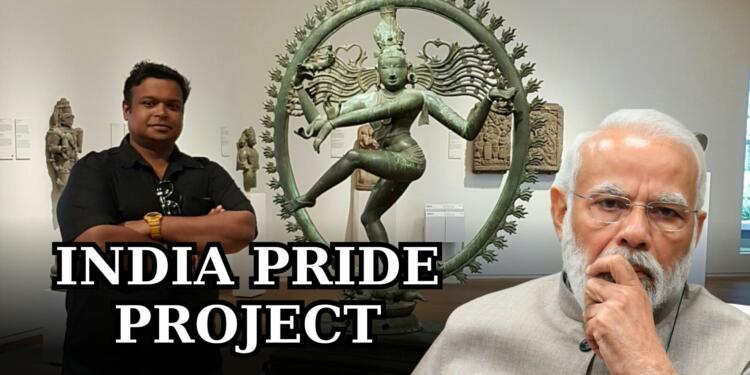India’s cultural heritage is under siege, facing a relentless onslaught from art smugglers and thieves. Despite recent successes in the restitution of stolen Indian artifacts, significant challenges persist, reflecting the ongoing struggle to safeguard the nation’s rich cultural legacy. Central to the efforts to reclaim these treasures is the India Pride Project (IPP), a global organization dedicated to restoring India’s lost heritage.
Historical Context and Legal Challenges
For decades, India has grappled with the issue of stolen artifacts, with limited success in their recovery. Past restitution efforts have been hampered by bureaucratic hurdles, inadequate legal frameworks, and a lack of concerted action. Despite sporadic attempts, the scale of the problem has often overwhelmed enforcement agencies, resulting in minimal returns of pilfered cultural treasures.
Discussion on the inadequacy of existing Indian antiquities laws
India’s antiquities laws, dating back to the colonial era, have proven insufficient in addressing the modern-day challenges of art theft and smuggling. The Antiquities and Art Treasures Act of 1972, while a step in the right direction, lacks the teeth needed to effectively combat illicit trafficking. Furthermore, enforcement mechanisms remain weak, with limited resources and capacity hindering the authorities’ ability to tackle the problem effectively.
Comparison with international standards and regulations
In contrast to India’s antiquated laws, international standards and regulations governing the protection of cultural heritage have evolved significantly. Countries like Egypt and China have implemented stringent measures, including capital punishment for heritage crimes, underscoring the seriousness with which they approach the issue. By comparison, India’s approach appears lackluster, with a reluctance to adopt more robust legal frameworks and enforcement mechanisms. This dichotomy highlights the need for urgent reforms to align India’s antiquities laws with global standards.
IPP’s Role and Methodology
The India Pride Project (IPP) emerged from a grassroots movement initiated by individuals passionate about preserving India’s cultural heritage. It traces its roots back to 2006 when S Vijay Kumar began documenting India’s heritage locations, uncovering inconsistencies and instances of missing artifacts. Over time, Kumar’s efforts gained momentum, attracting volunteers and collaborators from around the world. In 2014, Anuraag Saxena and Kumar officially founded IPP, consolidating their efforts under a unified banner.
IPP’s collaborative approach with law enforcement agencies
IPP operates on a collaborative model, forging partnerships with law enforcement agencies worldwide. Recognizing the limitations of governmental responses, IPP leverages its network of volunteers and expertise to assist authorities in tracking down stolen artifacts. By providing valuable insights and actionable intelligence, IPP enhances law enforcement’s capacity to combat art theft and smuggling. This collaborative approach has yielded significant results, leading to successful restitutions and prosecutions.
IPP in tracking and identifying stolen artifacts
IPP employs a multifaceted approach to tracking and identifying stolen artifacts. This includes maintaining a comprehensive database of stolen and missing artifacts, monitoring public and private auctions, and leveraging social media and historical documents for research. Through meticulous documentation and analysis, IPP identifies patterns and connections, enabling the identification of stolen artifacts and their eventual recovery. Additionally, IPP relies on its global network of volunteers to report suspicious activities and share relevant information with law enforcement agencies.
Also Read: OCI, NRI, or Dual Citizenship – The Great Debate
Significant Rebate Cases
IPP has played a pivotal role in facilitating the restitution of numerous stolen artifacts to India. These include iconic pieces such as the Sripuranthan Nataraja, the Uma, and the Alingana Murthy, among others. Through collaboration with law enforcement agencies and international partners, IPP has successfully traced stolen artifacts to their origins and advocated for their return to India.
Impact of these restitutions on India’s cultural heritage
The restitutions facilitated by IPP have had a profound impact on India’s cultural heritage, serving as a catalyst for broader awareness and action. Beyond the intrinsic value of the recovered artifacts, these restitutions symbolize a triumph of justice and a reaffirmation of India’s commitment to preserving its heritage. By reclaiming stolen treasures, India asserts its cultural sovereignty and underscores the importance of global cooperation in combating art theft and smuggling.
Examination of remaining challenges and missing artifacts
Despite these successes, significant challenges remain, with many stolen artifacts still unaccounted for. The scale of the problem necessitates continued vigilance and collaboration. IPP continues to advocate for stronger legal frameworks and enforcement mechanisms, as well as increased public involvement in heritage preservation efforts. Addressing these challenges requires sustained efforts and a collective commitment to safeguarding India’s cultural heritage for future generations.
International Collaboration and Recognition
IPP has established fruitful partnerships with foreign governments and agencies, serving as a valuable resource in the fight against art theft and smuggling. Through collaborative efforts, IPP has contributed to the successful restitution of stolen artifacts and enhanced international cooperation in heritage preservation.
Assessment of India’s response to international cooperation efforts
While IPP has demonstrated a proactive approach to international collaboration, India’s response has been mixed. While some progress has been made, bureaucratic hurdles and institutional inertia have hindered effective cooperation. There is a need for greater commitment and coordination from Indian authorities to fully leverage international partnerships.
Evaluation of barriers hindering effective collaboration
Barriers to effective collaboration include legal complexities, jurisdictional issues, and cultural differences. Additionally, resource constraints and competing priorities pose challenges to sustained cooperation. Overcoming these barriers requires enhanced communication, streamlined processes, and mutual respect for diverse perspectives.
Future Prospects and Recommendations
The future presents both challenges and opportunities in the fight against art theft and smuggling. Rapid globalization and advancements in technology present new avenues for illicit activities while increasing awareness and international cooperation offer potential solutions.
To address existing gaps in India’s antiquities laws and enforcement mechanisms, reforms are urgently needed. This includes updating outdated legislation, allocating resources for capacity-building, and fostering closer collaboration between government agencies and civil society organizations.
Public involvement is crucial in preserving India’s cultural heritage. Increased awareness campaigns, community engagement initiatives, and citizen-led conservation projects can empower individuals to take an active role in protecting their heritage.
In Conclusion, The recent restitutions facilitated by IPP underscore the importance of concerted efforts in reclaiming India’s stolen heritage. As guardians of our cultural legacy, we must remain vigilant and proactive in combating art theft and smuggling. Through global collaboration and collective action, we can ensure that India’s cultural treasures are preserved for future generations
Also Read: Mama, I’m in Love with a Criminal: Witness The Gangster Wedding































